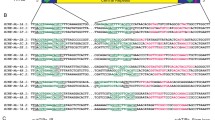Summary
DNA sequences from two spontaneous mutations of Drosophila melanogaster associated with insertion of a Doc transposable element have been cloned. In white-one, the element is inserted in the white locus close to where transcription initiates. In a lethal allele of suppressor of forked, su(f)S2, the element is inserted within the transcription unit in the protein coding region. Four other Doc elements have been cloned from a wild-type strain. Doc is a member of the class of transposable elements known as retroposons, which includes the D. melanogaster F, G, Jockey, and I elements. There is no sequence homology between the ends of the Doc element. The 3′ or right end terminates with a polyadenylation signal sequence followed by a stretch of oligo-A. The length of the oligo-A varies between elements, and a duplication of variable size is found as a direct repeat flanking inserted Doc elements. Members of the family are conserved at the 3′ end, but may be truncated at the 5′ or left end. These structural features suggest a mechanism of transposition via an RNA intermediate.
Similar content being viewed by others
References
Bender W, Akam M, Karch F, Beachy PA, Peifer M, Spierer P, Lewis EB, Hogness DS (1983) Molecular genetics of the bithorax complex of Drosophila melanogaster. Science 221:2329
Berger SL, Kimmel AR (1987) Guide to Molecular Cloning Techniques. Methods Enzymol 152
Di Nocera PP (1988) Close relationship between non-viral retroposons in Drosophila melanogaster. Nucleic Acids Res 16:4041–4052
Di Nocera PP, Digan ME, David I (1983) A family of oligo-adenylated transposable sequences in Drosophila melanogaster. J Mol Biol 168:715–727
Levis R, Bingham PM, Rubin GM (1982) Physical map of the white locus of Drosophila melanogaster. Proc Natl Acad Sci USA 79:564–568
Lindsley DL, Grell EH (1968) Genetic Variations of Drosophila melanogaster. Publication 627, Carnegie Inst Wash, DC
Mizrokhi LJ, Georgeiva SG, Ilyin YV (1988) jockey, a mobile Drosophila element similar to mammalian LINES, is transcribed from the internal promoter by RNA polymerase 11. Cell 54:685–691
Morgan TH (1910) Sex limited inheritance in Drosophila. Science 32:120–122
Morgan TH, Bridges CB (1916) Sex-linked inheritance in Drosophila. Publication 237, Carnegie Inst Wash, DC
O'Hare K, Murphy C, Levis R, Rubin GM (1984) DNA sequence of the white locus of Drosophila melanogaster. J Mol Biol 180:437–455
Pirrotta V, Brockl Ch (1984) Transcription of the white locus and some of its mutants. EMBO J 3:563–568
Priimagi AF, Mizrokhi LJ, Ilyin YV (1988) The Drosophila mobile element jockey belongs to LINES and contains coding sequences homologous to some retroviral proteins. Gene 70:253–262
Rogers JH (1985) The origin and evolution of retroposons. Int Rev Cytol 93:188–280
Sang HM, Pelisson A, Bucheton A, Finnegan DJ (1984) Molecular lesions associated with white gene mutations induced by I-R hybrid dysgenesis in Drosophila melanogaster. EMBO J 3:3079–3085
Schalet A (1986) The distribution of an complementation relationships between spontaneous X-linked recessive lethal mutations recovered from crossing long-term laboratory stocks of Drosophila melanogaster. Mutat Res 163:115–144
Schneuwly S, Kuroiwa A, Gehring WJ (1987) Molecular analysis of the dominant homeotic antennapedia phenotype. EMBO J 6:201–206
Steller H, Pirrotta V (1985) Expression of the Drosophila white gene under the control of the hsp70 heat shock promoter. EMBO J 4:3765–3722
Toh H, Kikuno R, Hayashida H, Miyata T, Kugimiya W, Inouye S, Yuki S, Saigo K (1985) Close structural resemblance between putative polymerase of a Drosophila transposable genetic element 17.6 and pol gene product of Moloney murine leukaemia virus. EMBO J 4:1267–1272
Zachar Z, Bingham PM (1982) Regulation of white locus expression: the structure of mutant alleles at the white locus of Drosophila melanogaster. Cell 30:529–541
Author information
Authors and Affiliations
Additional information
Communicated by D.J. Finnegan
Rights and permissions
About this article
Cite this article
Driver, A., Lacey, S.F., Cullingford, T.E. et al. Structural analysis of Doc transposable elements associated with mutations at the white and suppressor of forked loci of Drosophila melanognster . Molec. Gen. Genet. 220, 49–52 (1989). https://doi.org/10.1007/BF00260854
Received:
Issue Date:
DOI: https://doi.org/10.1007/BF00260854




